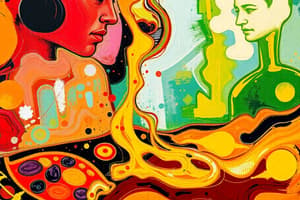Podcast
Questions and Answers
Recently, discovering foods that worked together well was largely trial and error, but a rise in ______ chefs has seen a new 'science' of food pairing.
Recently, discovering foods that worked together well was largely trial and error, but a rise in ______ chefs has seen a new 'science' of food pairing.
experimental
Researchers have cataloged the flavor compounds of hundreds of foods, showing that classical food combinations do share many flavor ______.
Researchers have cataloged the flavor compounds of hundreds of foods, showing that classical food combinations do share many flavor ______.
compounds
The theories do not account for a food’s ______ and don’t always hold true for Asian and Indian cuisines.
The theories do not account for a food’s ______ and don’t always hold true for Asian and Indian cuisines.
texture
Two highly potent flavor molecules that convey butter’s buttery and creamy aroma are diacetyl and ______.
Two highly potent flavor molecules that convey butter’s buttery and creamy aroma are diacetyl and ______.
Grass-fed beef pairs well with heated milk flavors, owing to pasture-raised cattle’s higher concentration of fatty-flavored ______ chemicals present in the meat.
Grass-fed beef pairs well with heated milk flavors, owing to pasture-raised cattle’s higher concentration of fatty-flavored ______ chemicals present in the meat.
Maillard reactions begin at around ______ºF (140ºC)
Maillard reactions begin at around ______ºF (140ºC)
At ______ºF (150ºC), new flavor molecules are generated twice as quickly as at 284ºF.
At ______ºF (150ºC), new flavor molecules are generated twice as quickly as at 284ºF.
When food reaches ______ºF (180ºC), pyrolysis begins.
When food reaches ______ºF (180ºC), pyrolysis begins.
The process of browning in cooking is called the ______ reaction.
The process of browning in cooking is called the ______ reaction.
The flavor enhancement peaks at ______ºF (160°C).
The flavor enhancement peaks at ______ºF (160°C).
As temperatures increase, ______ and sugars clash in the Maillard reaction.
As temperatures increase, ______ and sugars clash in the Maillard reaction.
Before food begins to blacken, ______ and nutty flavors are created.
Before food begins to blacken, ______ and nutty flavors are created.
Carbohydrates, proteins, and fats break down, producing some potentially ______ substances.
Carbohydrates, proteins, and fats break down, producing some potentially ______ substances.
The animal was grass-fed in ______ meat
The animal was grass-fed in ______ meat
The surfaces should be smooth and not appear ______ or slimy
The surfaces should be smooth and not appear ______ or slimy
Breast meat should be firm and ______
Breast meat should be firm and ______
Meat should have a mild but not ______ smell
Meat should have a mild but not ______ smell
Bones should be intact and blemish-______
Bones should be intact and blemish-______
For tender cuts, choose one with a fine ______
For tender cuts, choose one with a fine ______
For tough cuts, the grain will be ______, indicating usage
For tough cuts, the grain will be ______, indicating usage
Tissue should not be broken to ensure the ______ is intact
Tissue should not be broken to ensure the ______ is intact
If it stays ______, this suggests that the animal may have been stressed at slaughter.
If it stays ______, this suggests that the animal may have been stressed at slaughter.
When meat is dry-aged by butchers, it darkens, its taste intensifies, and it loses ______.
When meat is dry-aged by butchers, it darkens, its taste intensifies, and it loses ______.
Once a package has been opened and oxygen comes into contact with the ______, the tissue becomes bright red.
Once a package has been opened and oxygen comes into contact with the ______, the tissue becomes bright red.
If continuously exposed to oxygen, meat gradually ______.
If continuously exposed to oxygen, meat gradually ______.
Brown meat may not be ______—use your senses of touch and smell to judge whether it is okay to eat.
Brown meat may not be ______—use your senses of touch and smell to judge whether it is okay to eat.
CARBON MONOXIDE is sometimes added to vacuum packs—it reacts with ______, turning meat red.
CARBON MONOXIDE is sometimes added to vacuum packs—it reacts with ______, turning meat red.
After a week, meat turns a deeper red as the oxygen reacts with the ______.
After a week, meat turns a deeper red as the oxygen reacts with the ______.
When meat is exposed to oxygen, it becomes bright red due to the reaction with ______.
When meat is exposed to oxygen, it becomes bright red due to the reaction with ______.
Braise or stew small, lean cuts to conserve ______,
Braise or stew small, lean cuts to conserve ______,
Fat turns into oil when ______,
Fat turns into oil when ______,
Marbled muscle can be ______ slowly.
Marbled muscle can be ______ slowly.
The freshest red meat is often thought to be bright ______,
The freshest red meat is often thought to be bright ______,
Ask your butcher for their tastiest cut, and you might be shown one with a darker ______.
Ask your butcher for their tastiest cut, and you might be shown one with a darker ______.
Fat enhances ______.
Fat enhances ______.
When buying red meat, consider the way it is ______ over time.
When buying red meat, consider the way it is ______ over time.
A checklist helps you judge meat when making a ______.
A checklist helps you judge meat when making a ______.
Study Notes
Maillard Reactions and Cooking Temperatures
- 284°F (140°C): Maillard reactions begin, resulting in browning and the creation of new flavors and aromas.
- 302°F (150°C): Maillard reactions intensify, generating flavors twice as quickly as at 284°F.
- 320°F (160°C): Molecular changes continue, resulting in a peak in flavor enhancement.
- 356°F (180°C): Pyrolysis occurs, causing food to char and potentially harmful substances to form.
Food Pairing
- Researchers have cataloged flavor compounds in various foods, uncovering shared flavor profiles.
- Classical food pairings often share flavor compounds, while new pairings reveal unexpected matches.
- Texture and cultural variations can influence food pairings, challenging traditional theories.
Identifying Quality Meat
- Red Meat: Look for a dark hue, indicating aging for deeper flavor and tenderness. Yellow fat suggests grass-fed cattle.
- White Meat: Breast meat should be firm and plump, with a mild odor. Surfaces should be smooth and not sticky or slimy.
Meat Characteristics
- Muscle: Contains protein and moisture, affecting tenderness and cooking methods.
- Fat: Contributes flavor and moisture. Thicker cuts tend to be richer.
- Connective tissue: Affects tenderness, with more being present in tougher cuts requiring longer cooking times.
Meat Color and Aging
- Red meat: Turns bright red upon exposure to oxygen. Gradually darkens over time, indicating aging, not spoilage.
- Dry-aged meat: Darkens, intensifies in flavor, loses moisture, and shrinks.
Carbon Monoxide in Meat Packaging
- Can be added to vacuum packs to enhance the red color of meat.
- Reacts with myoglobin, keeping the meat red for a longer period.
Studying That Suits You
Use AI to generate personalized quizzes and flashcards to suit your learning preferences.
Related Documents
Description
Test your knowledge on Maillard reactions and how they influence cooking temperatures and food flavors. Explore the science of flavor compounds and discover the best practices for identifying quality meat. Prepare to enhance your culinary expertise with various food pairing insights.





